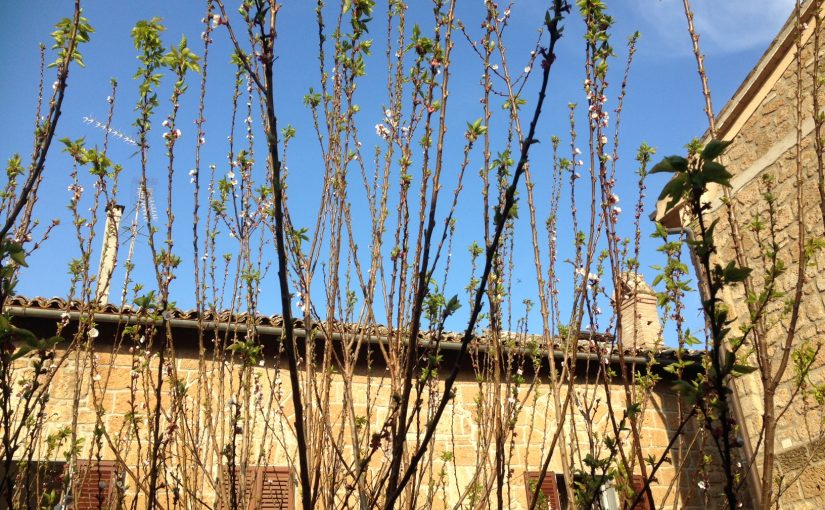In my yard there is an apricot tree. It was one of the reasons I took to this place so quickly. My mother’s parents had an apricot orchard in Cupertino, California; ten acres that my uncle farmed until the mid-seventies when they were parceled out to make room for an electrical substation and a go-cart park. He was getting tired of farming, no reason not to sell, and the land was being taxed as commercial which made farming impossible, but for all of us it was ceding away a piece of the family.
So, when I took over care of the tree in my yard, I felt somehow qualified by birth to do so. Never mind that it was a variety of apricot I’d never seen before. Never mind the depth of my agricultural training consisted of many a July spent first, playing house with my cousin, Gail, under the shelters built by our adult relatives using drying trays, then, as we became old enough to wield a knife, cutting “cots” at those same trays, arranging them in neat rows to be set in the California sun for a week before they were weighed and boxed for Del Monte, or another distribution company. Never mind that my only other experience was an hour with my father at another tree in another yard at another place I lived, in Santa Cruz, when he demonstrated and explained how best to prune an apricot for a solid yield, and that was in 1980. Apricots were in my blood. I could do this.
The tree had not been pruned in years. Concerned neighbors stopped me on the street to inquire about my plans for it.
“If it is allowed to get bigger, it will send roots into the foundations of the house.”
“Best to prune in February before it begins to grow, but when it’s cold enough to prevent disease from infecting the cuts,” I responded knowingly, quoting Dad from thirty-six years prior.
I still remembered his exact instructions: remove crossed branches and suckers, trim frutaceous branches to the fifth lateral bud, prune for shape and ease of accessing fruit. Simple, right?
Well, the first pruning would reflect none of that. I had to purchase a chain saw. This was not a matter of selective trimming, there were branches that needed to come off, and some were thick enough and heavy enough to qualify as timber.
The tree recovered beautifully, but produced few blossoms. The crop that year – four. Apricots.
Having been largely shaped, the next February I greeted the tree with optimism. While the first pruning took a week, the second was finished in five hours, with my friend Lucky turning the trimmings into kindling for the following winter as the branches fell. To be honest, I stood looking at the tree, tools in hand, for quite awhile beforehand, trying to apply my father’s instructions to an actual tree, and ended up just hacking at whatever seemed right at the moment. So much for family line.
The tree bloomed handsomely and grew a luxuriant crop of leaves. Oh, and an increased bounty of fruit – five. Apricots.
Maria, who has fruit trees in the country, and Renzo, who worked as a plant sales and delivery person for more than a dozen years, explained that the rain had come at exactly the wrong time that spring, knocking blossoms off before they could set. Vivid memories of my mother lamenting April showers that arrived a few days early, sprung to mind.
Last year, I wasn’t fit for the job, so hired a guy to prune. He approached the tree, sized it up, and proceeded methodically. I was encouraged. When I looked at it with attention a week or so later, I realized that he had trimmed entirely for shape, and we would most likely be back to square one; that is, a crop of four instead of five. Apricots. Yep.
“When nobody took care of it at all, there was enough fruit for the whole neighborhood!” Renzo noted by way of comforting me.
January rolled around, and I asked Renzo if he might be able to prune the tree. I like apricots, it would be nice if the tree did, too.
“No, I really don’t know anything about pruning, but I know a guy who does, I’ll ask him.”
I managed to wait a week without bugging him about it. Late January arrived, I was getting anxious, and Renzo, now retired, was not around much. Finally, we ran into each other on the street.
“Yeah, I asked that guy. He said leave it alone, let it bloom and bear, then after the harvest prune it severely, down to the main branches. The tree will grow back vigorously in two or three weeks, and the crop before that will be good.”
Forty years of received wisdom went up in smoke. I know that’s not how my family did things, but hey, this ain’t Cupertino. At least, I don’t think it’s how they did things. But then again, my dad, the one who imparted the agricultural know-how to his theatre-guy son? was an auto mechanic.
The tree has blossomed nicely, though not the full cover I was expecting. It rained, but few blossoms fell. And now leaves are showing in clumps. None of it looks right to me, or familiar, but I bet there’s a crop good enough to supply the neighbors, and regardless of how we got there, that would be great.
